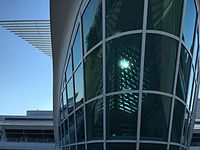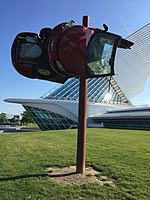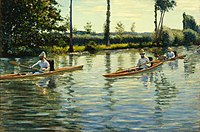Milwaukeeské umělecké muzeum
| Milwaukee Art Museum | |
|---|---|
 | |
| Údaje o muzeu | |
| Stát | |
| Adresa | Milwaukee, Spojené státy americké |
| Založeno | 1888 |
| Zeměpisné souřadnice | 43°2′23,62″ s. š., 87°53′49,35″ z. d. |
| Webové stránky | |
| Některá data mohou pocházet z datové položky. | |
Milwaukeeské umělecké muzeum (Milwaukee Art Museum, zkratkou MAM) je umělecká galerie v Milwaukee v USA[1] se sbírkou přes 30 000 uměleckých děl.
Historie
V roce 1872 několik městských organizací rozhodlo o vytvoření galerie umění v Milwaukee, jelikož město rostlo a neexistoval objekt pro umělecké výstavy. Již během několika let jejich snaha přinesla ovoce. Rezident Milwaukee Alexander Mitchell daroval v roce 1882 městu své sbírky.
V roce 1888 založili v Milwaukee místní podnikatelé Milwaukee Art Association. Ve stejném roce anglo-americký podnikatel Frederick Leighton založil galerii Layton Art Gallery, nyní neexistující. V roce 1911 vytvořil Institut umění Milwaukee, další budovu pro výstavy a skladování sbírek, která byla umístěna v blízkosti galerie Layton. Poté v roce 1957 vznikl Milwaukee Art Center (nyní Muzeum umění Milwaukee) spojením Milwaukee Art Institute a sbírek Artton Art Gallery a byl přesunut do nové budovy navržené a postavené finským architektem Eero Saarinenem.
Španělský architekt Santiago Calatrava v letech 1994–2001 vybudoval Quadracci Pavilion jako svou první stavbu v USA. Impozantní vstupní halu ze skla a oceli, vysokou 27 metrů, je možné zastínit pohyblivou sluneční clonou, jež se stala orientačním bodem pro návštěvníky muzea.
Aktivita
V současné době zahrnuje 31 000 m² muzejního komplexu o rozloze 341 000 metrů čtverečních: válečné památkové centrum (1957), budovu Kahler Building (1975) a Pavilion Quadracci (2001). V roce 2004 získal Quadracci Pavilion za svou jedinečnou architekturu ocenění Outstanding Structure Award od International Association for Bridge and Structural Engineering (Mezinárodní asociace mostů a stavebního inženýrství). Sbírka muzea se nachází ve čtyřech patrech a zahrnuje umělecká díla od starověku až po současnost.
Sbírky
Zajímavosti
Zajímavé je, že v muzeu se konaly další akce:
- v roce 2010 se uskutečnil casting 10. ročníku American Idol;
- v roce 2011 byl Pavilion Quadracci využit k natáčení fantastického akčního filmu Transformers 3: The Dark Side of the Moon;
- premiéra videohry Forza Motorsport 4 (v roce 2011).
Odkazy
Reference
V tomto článku byl použit překlad textu z článku Художественный музей Милуоки na ruské Wikipedii.
- ↑ Milwaukee Art Museum[nedostupný zdroj]
- ↑ The Flag [online]. [cit. 2017-01-16]. Dostupné online. (anglicky)
- ↑ The Flag [online]. [cit. 2017-01-16]. Dostupné online. (anglicky)
Externí odkazy
 Obrázky, zvuky či videa k tématu Milwaukee Art Museum na Wikimedia Commons
Obrázky, zvuky či videa k tématu Milwaukee Art Museum na Wikimedia Commons - Art Museum official website[nedostupný zdroj]
- Milwaukee Art Museum at Google Cultural Institute
Média použitá na této stránce
Autor: mareklug from Chicago/Cincinnati, Poland, now United States, Licence: CC BY-SA 2.0
Milwaukee Art Museum/Lakefront, from the North, in foreground: wrecked car around and on a pole installation
Autor: Frank Lloyd Wright , Licence: CC BY 3.0
Autor: , Licence: CC BY 3.0
Paintings in the Milwaukee Art Museum
"Kolty" (singular "kolt") are pendants that attached to a woman's headdress at the temples. The hollow space within the two concave gold disks that compose a "kolt" contained perfumes or scented oils. The pendants were usually decorated on both sides, since they could rotate as the woman walked. This "kolt" is decorated with delicate cloisonné enamel, a technique learned from Byzantine masters starting in the late 10th century. "Kolty" were frequently worn at wedding ceremonies; the lilies (center), birds, and seeds that fleck the birds' breasts are all symbols of fertility. The bird is also an image retained from Russia's pagan past.
Autor: Michael Hicks (Mulad), Licence: CC BY 2.0
Milwaukee Art Museum, Burke brise soleil above the Quadracci Pavilion, version 1
img_2349
At the turn of the 20th century, Tiffany and Co. produced a number of fabulous, realistic floral brooches. This extravagant example designed by G. Paulding Farnham was in the firm's display at the Exposition Universelle of 1900. It is set with faceted blue sapphires mined, which vary in intensity of color and hue as well as size. The blossom is composed of three sepals, or upright petals, and three falls, or drooping sepals, in oxidized silver, beneath which are three small small branches in etched gold. The bearding of the falls is suggested by citrines mounted in gold collets. The blossom emerges from a long, etched gold stem, from which spring three spathes rendered in demantoid garnets mounted "a jour" in gold frames.
Autor: mareklug from Chicago/Cincinnati, Poland, now United States, Licence: CC BY-SA 2.0
The late afternoon sun shines through all the glass surfaces right through at the central vestibule of the Milwaukee Art Museum on the city's Lakefront
Autor: Meganwh, Licence: CC BY-SA 3.0
The original Layton Art Gallery, circa 1888, located at 758 N Jefferson St., the northeast corner of Mason Street & Jefferson Street. The building was vacated in 1957 and demolished in 1958.
Autor: Dasparag, Licence: CC BY-SA 4.0
This is a picture from the shore area around Milwaukee Art Museum







![Georgia O'Keeffe, The Flag, watercolor and graphite on paper, 12 × 8 3/4 in. (30.5 × 22.2 cm), 1918[2][3]](http://upload.wikimedia.org/wikipedia/commons/thumb/4/45/Georgia_O%27Keeffe%2C_The_Flag%2C_watercolor%2C_1918%2C_MAM.tif/lossless-page1-149px-Georgia_O%27Keeffe%2C_The_Flag%2C_watercolor%2C_1918%2C_MAM.tif.png)















